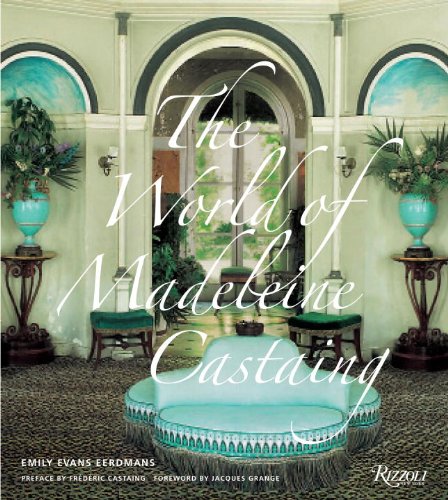 |
| Mlle Dervieux's boudoir |
For as long as I can remember, I have been fascinated by that singularly glamorous creature, the Courtesan. Living outside of society's constraints and approval, hers was a life dedicated to mastering the art of pleasure in all its forms - intellectual and sensual.
It was a job requirement to be dressed fashionably and sumptuously and her quarters, as an extension of her person, were just as exquisitely equipped. The Opera dancer Anne-Victoire Dervieux (1752 - 1826) was one such mistress who was so passionate about her Paris neoclassical hotel particulier that she eventually married her architect François-Joseph Bélanger.*
The house on the rue Chantereine (now the rue de la Victoire) was fabled for its elegance. The Baronne d'Oberkirch was one of the many who toured it - while its mistress was out, of course - and described it in her memoirs: "It was a gem. The furniture alone was worth a king's ransom. Both court and city had contributed to its decoration."
The two story house was first constructed by Alexandre Brongniart, but was redesigned by Belanger in 1788 in the latest Pompeian taste.
The brothers Goncourt called it the most splendid of the small-scale hotels, "with its bathroom in the Etruscan fashion, the dining room preciously worked with silver arabesques, painted figures, and mahogany and lemon wood married together." Most petites maisons were sited on the outskirts of Paris where men could engage in all sorts of unsavory pursuits away from society. If interested, I highly recommend the 18th century novel La Petite Maison which narrates the seduction of a young woman through the architectural delights of a maison de plaisance.
Belanger was at the forefront of French neoclassicism which drew upon the arabesque decoration found in the Ancient Roman murals in Pompeii. (Compare with his British contemporary Robert Adam who was similarly influenced.)
A rare exhibition of 20 watercolor designs was recently on view at Didier Aaron in London. My dear friend Marc sent me a few images from the show, which I hope some of you had the good fortune to see. For more, click here.
One of Belanger's most important clients was the Comte d'Artois who, surely no coincidence, was one of Dervieux's supporters. I couldn't help but include Belanger's charming design for the comte's bedroom at the chateau de Bagatelle in the Bois du Boulogne.
For more reading pleasure, curl up with Katie Hickman's Courtesans: Money, Sex and Fame in the Nineteenth Century and Mistresses: True Stories of Seduction Power and Ambition by Leigh Eduardo. Of course, I am always looking to expand my library on licentious ladies, if you have any suggestions....













13 comments:
Guess who missed the show in London, dammit. But thank you for this - in fact two marvellous posts for the price of one!
Ah, the courtesan—a word with many meanings. One of which, of course, is a prostitute with a courtly, wealthy, or upper-class clientele. Stripping away all nuance, this definition could be, of course, applied to many marriages of then, and now. And the homes where the courtesan did reign, a stately pleasure dome decree? One can hope that pleasure did reign even if it were in a quid pro quo arrangement.
I've always been fascinated by these women! When you see photos of many of the Belle Epoque ones, they're often shocking UN-attractive! Yet they charmed men with their open lifestyles, wit, intelligence and glamour. And really -isn't that more attractive then just a pretty face?
Rosie, you should stop by Didier Aaron in any case. The watercolors may still be there, and you will get to spend time with the lovely Marc - of that, I will be extraordinarily jealous.
Home, So so true - in fact, I kept changing the tense back and forth from past to present. I can think of so many socialites who started their careers as flight attendants or some such, and they act more as geisha to their husband than partner. I suppose without a rigid class system in place, we can now marry our courtesans, and as they get older, trade them in for a newer model.
Stefan, YES! Weren't so many portly with moustaches - yet they had IT! Truly fascinating.
Lovely. I think I need a replica of this maison de plaisance made for me - maybe in Savannah . . . was this plan found in a publication?
KDM
KDM, I think so and Savannah is the perfect place to install it. I found the plan and a few others at the Biblioteque Nationale: http://images.bnf.fr/jsp/index.jsp?destination=afficherListeCliches.jsp&origine=rechercherListeCliches.jsp&contexte=resultatRechercheSimple - a great place to while away the hours! EEE
I've been reading Charles Washburn's 1936 book Step into My Parlor, the biography of Chcago's notorious Everleigh sisters, who ran Chicago's most elegant resort for a decade at the turn of the last century.
Minna Everleigh not only expected her 'butterflies' to be beautiful, but, more importantly, to poised, well read and able to carry on an intelligent conversation with guests in club's numerous public parlors, where no hint of vulgarity in dress or conduct was ever permitted. "Just forget what you're here for, girls" is how she put it. "A gentleman is only a gentleman when properly introduced. Stay respectable by all means."
The rates at the Everleigh Club were ten times what the rest of the market was charging, but even so, they would only get a guest as far as one of the first-floor parlors for a bit of high-toned conversation. Anything that went on upstairs afterwards was extra.
Etiquette & refinement didn't come cheap at the Everligh Club, but as Minna explained to a reporter "Don't forget, entertaining most men at dinner or in any one of our parlors is more tiring than what the girls lose their social standing over."
So what happened to the social niche once inhabited by elegant, intelligent courtesans established in attractive houses of their own? Well, long before Match.com, Minna had a theory: "If it weren't for married men, we could never have made a go of it at all, but if it werent for all the cheating married women, we could have made another million." When supply goes up, demand goes down.
Great post - the people (and the passion, in more ways than one) behind the architecture.
EEE, these renderings are sublime. Designing an interior meant purely for pleasure does give one a certain element of freedom, I suppose.
What an interesting article, with terrific pictures and links. I love a well researched post and read every word. I am about to pop over to Didier Aaron gallery in London to see what's going on there. Thanks!
Liz
P.S. my word verification is nested, very auspicious, finally!
This is sumptuous. From the scale and decor of the rooms to the imagined whisper of the perfumed gowns crossing the floor by those women of dubious distinction - the courtesans. How they did rule in their own charmingly subtle way, perfecting polite compliance or what one NY Times columnist recently described as the "lost art of self-effacement."
Correction: The Lost Virtue of Self-effacement.
what a gem indeed. are any of theese places left? meanwhile, if anyone wants to decorate like that right now, please call me, i am happy to help!
Post a Comment